TESCO Marketing Management: Strategies for Enhanced Branding
VerifiedAdded on 2023/06/15
|12
|3988
|231
Report
AI Summary
This report provides a comprehensive analysis of TESCO's marketing management strategies, focusing on enhancing market presence and brand reputation. It includes an overview of the organization, its competitive environment analyzed through Porter's Five Forces and SWOT analysis, and a detailed examination of its marketing mix (4Ps/7Ps). The report identifies opportunities and threats impacting TESCO, and offers recommendations for improving its branding, product positioning, and overall marketing effectiveness, including revamping products and services to meet evolving customer needs and technological advancements. The analysis covers aspects like customer feedback, vegetarian options, and technology upgrades to strengthen TESCO's brand image and market position.
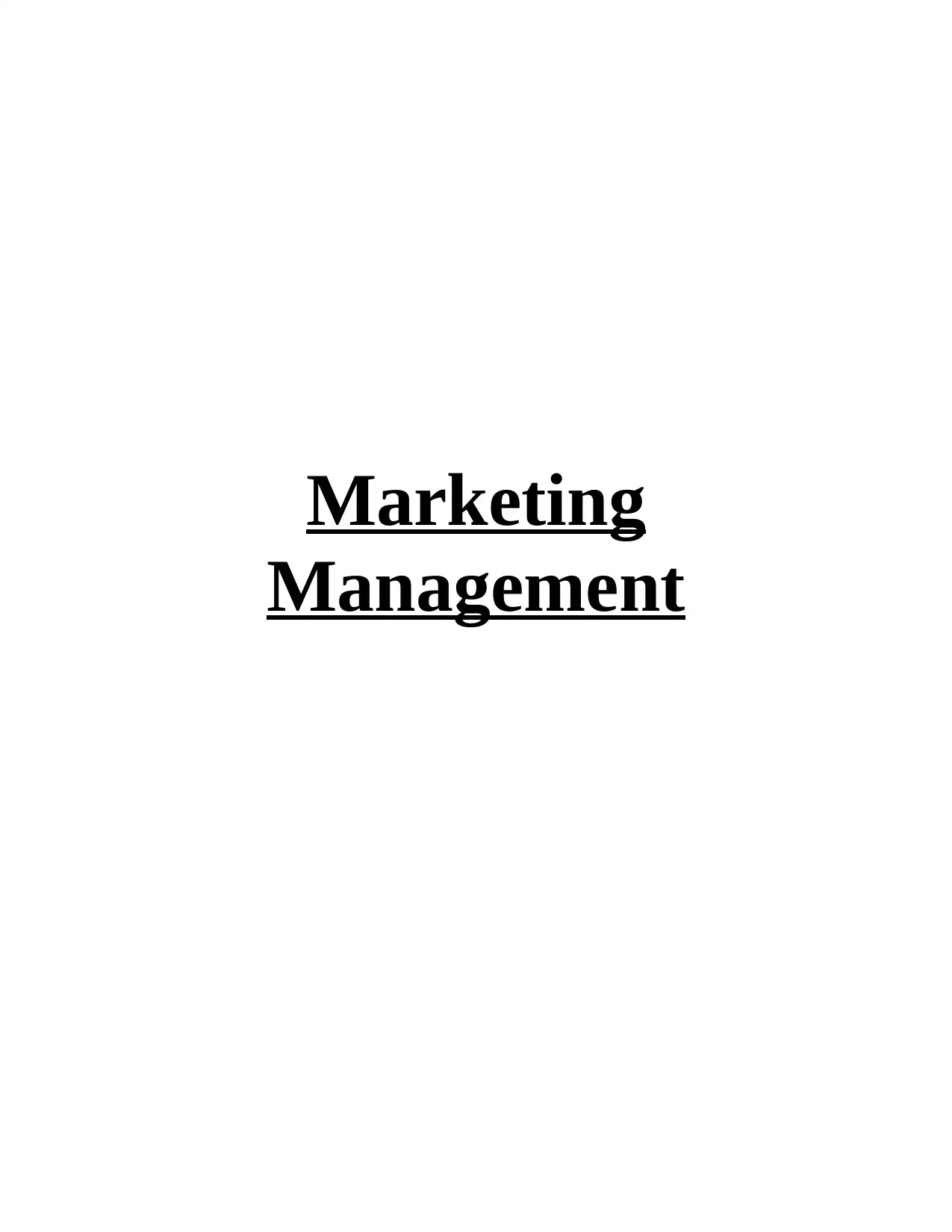
Marketing
Management
Management
Paraphrase This Document
Need a fresh take? Get an instant paraphrase of this document with our AI Paraphraser
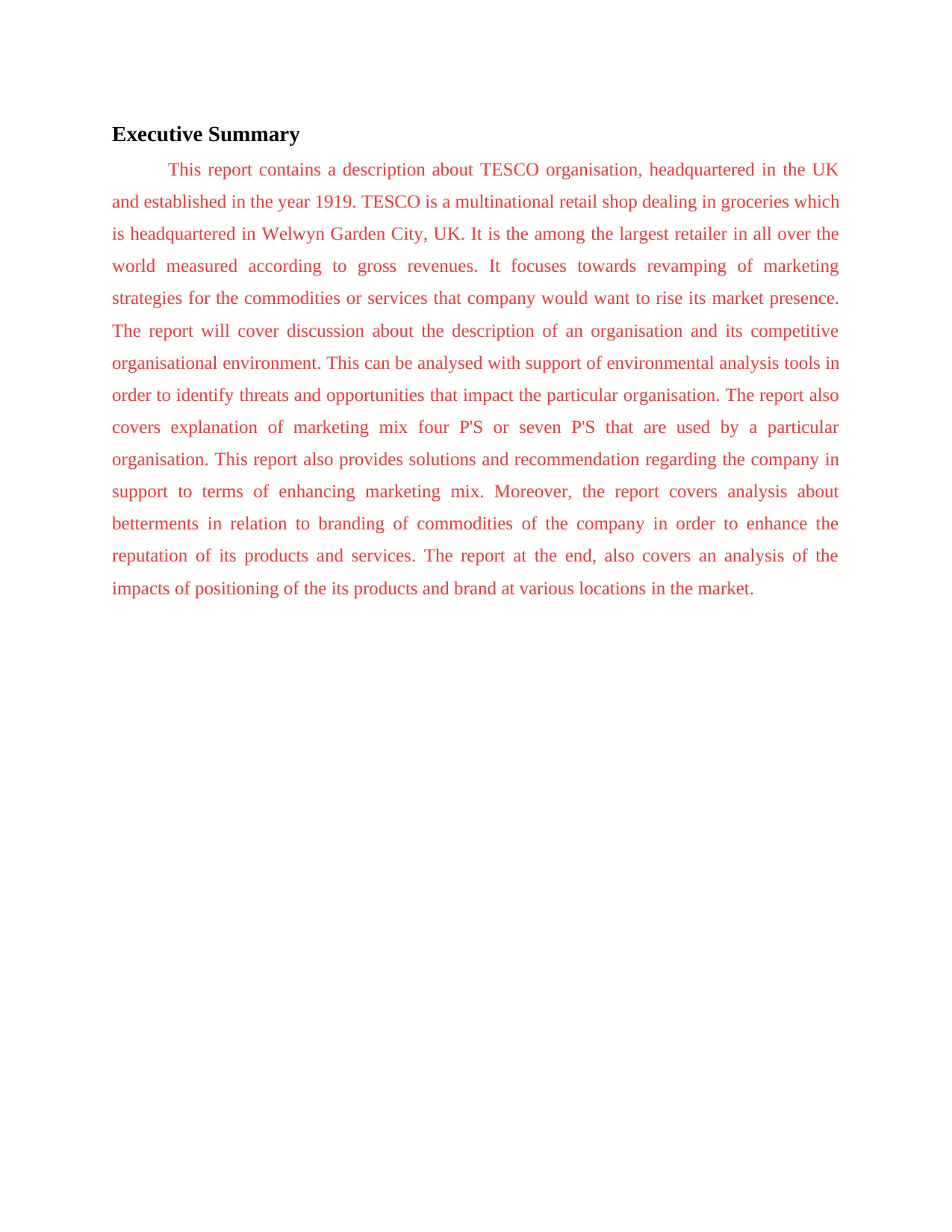
Executive Summary
This report contains a description about TESCO organisation, headquartered in the UK
and established in the year 1919. TESCO is a multinational retail shop dealing in groceries which
is headquartered in Welwyn Garden City, UK. It is the among the largest retailer in all over the
world measured according to gross revenues. It focuses towards revamping of marketing
strategies for the commodities or services that company would want to rise its market presence.
The report will cover discussion about the description of an organisation and its competitive
organisational environment. This can be analysed with support of environmental analysis tools in
order to identify threats and opportunities that impact the particular organisation. The report also
covers explanation of marketing mix four P'S or seven P'S that are used by a particular
organisation. This report also provides solutions and recommendation regarding the company in
support to terms of enhancing marketing mix. Moreover, the report covers analysis about
betterments in relation to branding of commodities of the company in order to enhance the
reputation of its products and services. The report at the end, also covers an analysis of the
impacts of positioning of the its products and brand at various locations in the market.
This report contains a description about TESCO organisation, headquartered in the UK
and established in the year 1919. TESCO is a multinational retail shop dealing in groceries which
is headquartered in Welwyn Garden City, UK. It is the among the largest retailer in all over the
world measured according to gross revenues. It focuses towards revamping of marketing
strategies for the commodities or services that company would want to rise its market presence.
The report will cover discussion about the description of an organisation and its competitive
organisational environment. This can be analysed with support of environmental analysis tools in
order to identify threats and opportunities that impact the particular organisation. The report also
covers explanation of marketing mix four P'S or seven P'S that are used by a particular
organisation. This report also provides solutions and recommendation regarding the company in
support to terms of enhancing marketing mix. Moreover, the report covers analysis about
betterments in relation to branding of commodities of the company in order to enhance the
reputation of its products and services. The report at the end, also covers an analysis of the
impacts of positioning of the its products and brand at various locations in the market.
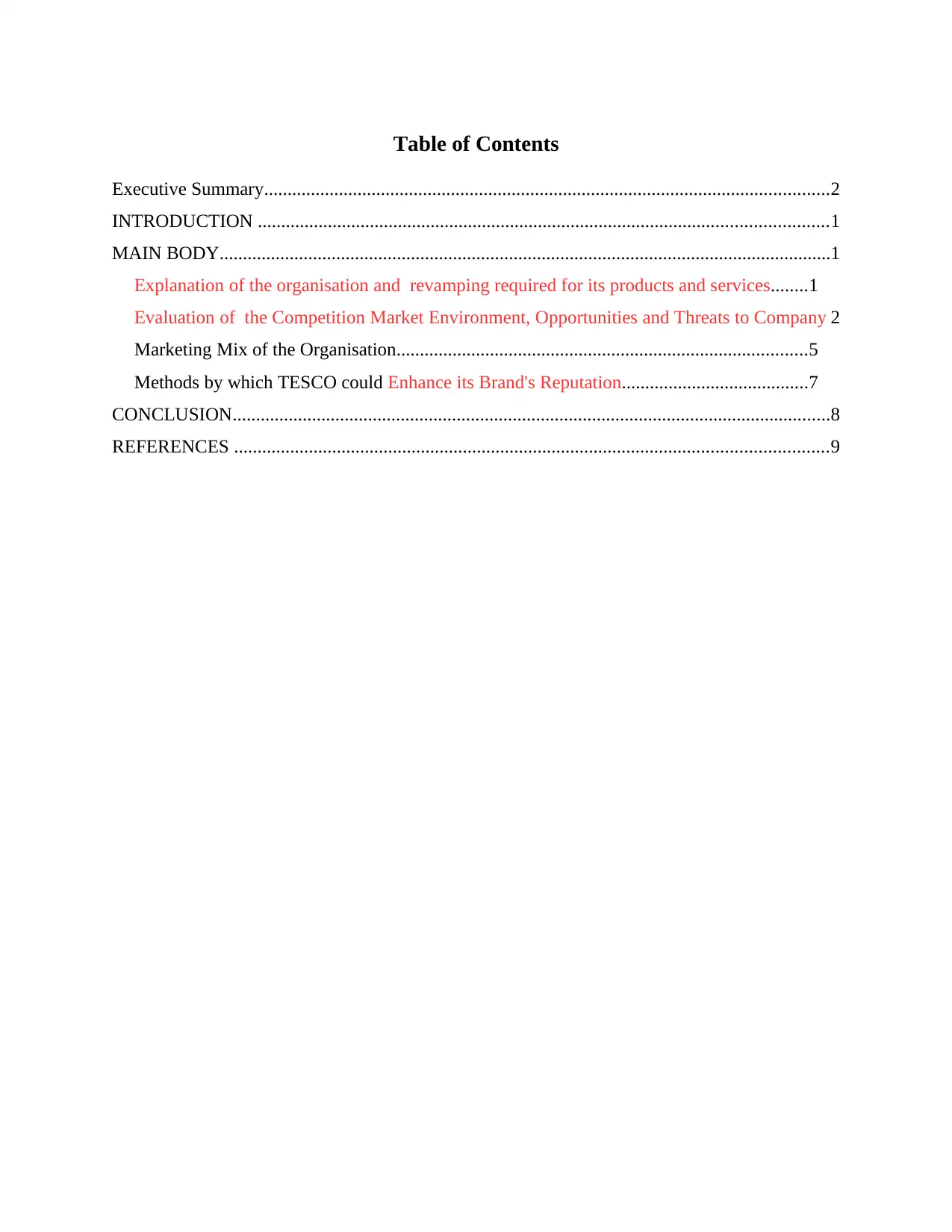
Table of Contents
Executive Summary.........................................................................................................................2
INTRODUCTION ..........................................................................................................................1
MAIN BODY...................................................................................................................................1
Explanation of the organisation and revamping required for its products and services........1
Evaluation of the Competition Market Environment, Opportunities and Threats to Company 2
Marketing Mix of the Organisation........................................................................................5
Methods by which TESCO could Enhance its Brand's Reputation........................................7
CONCLUSION................................................................................................................................8
REFERENCES ...............................................................................................................................9
Executive Summary.........................................................................................................................2
INTRODUCTION ..........................................................................................................................1
MAIN BODY...................................................................................................................................1
Explanation of the organisation and revamping required for its products and services........1
Evaluation of the Competition Market Environment, Opportunities and Threats to Company 2
Marketing Mix of the Organisation........................................................................................5
Methods by which TESCO could Enhance its Brand's Reputation........................................7
CONCLUSION................................................................................................................................8
REFERENCES ...............................................................................................................................9
⊘ This is a preview!⊘
Do you want full access?
Subscribe today to unlock all pages.

Trusted by 1+ million students worldwide
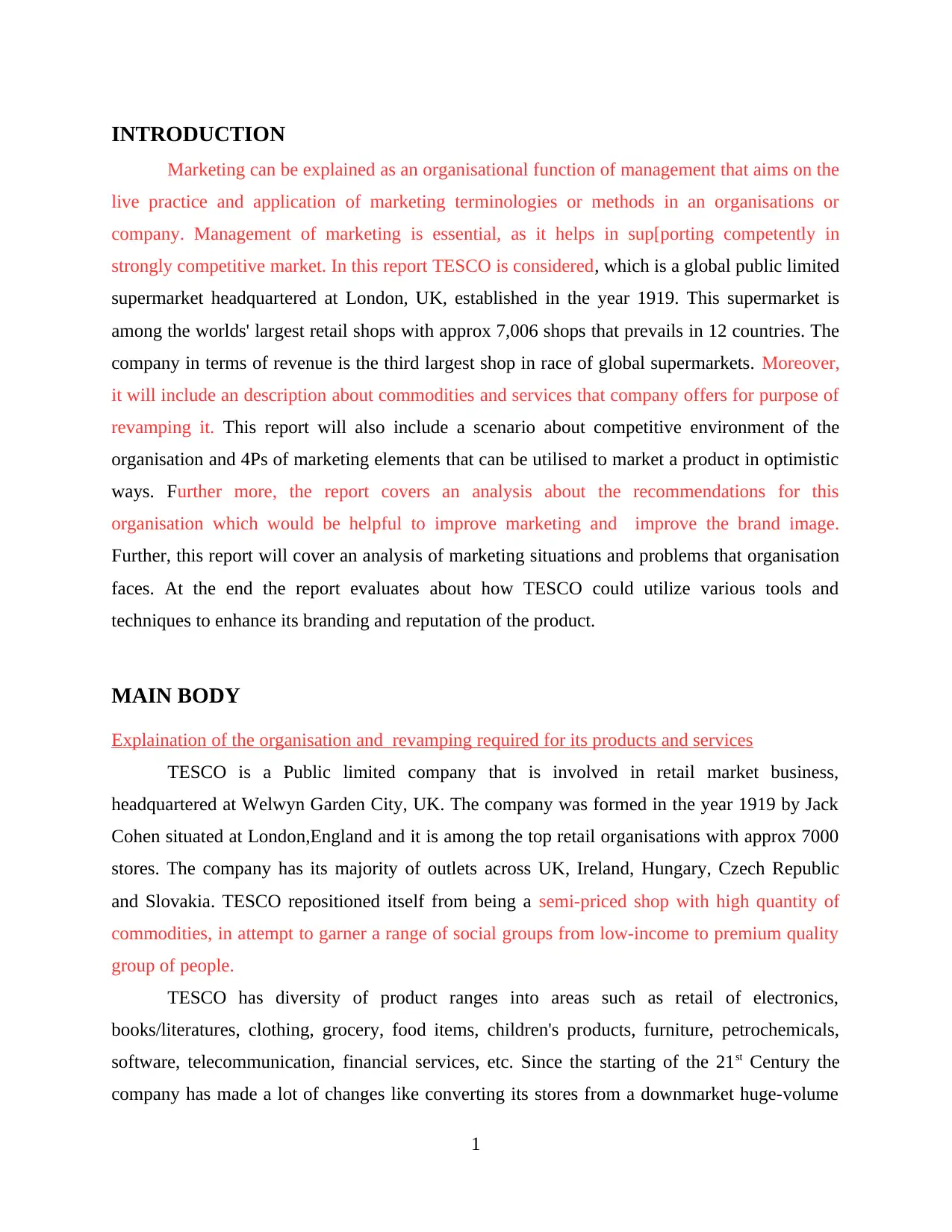
INTRODUCTION
Marketing can be explained as an organisational function of management that aims on the
live practice and application of marketing terminologies or methods in an organisations or
company. Management of marketing is essential, as it helps in sup[porting competently in
strongly competitive market. In this report TESCO is considered, which is a global public limited
supermarket headquartered at London, UK, established in the year 1919. This supermarket is
among the worlds' largest retail shops with approx 7,006 shops that prevails in 12 countries. The
company in terms of revenue is the third largest shop in race of global supermarkets. Moreover,
it will include an description about commodities and services that company offers for purpose of
revamping it. This report will also include a scenario about competitive environment of the
organisation and 4Ps of marketing elements that can be utilised to market a product in optimistic
ways. Further more, the report covers an analysis about the recommendations for this
organisation which would be helpful to improve marketing and improve the brand image.
Further, this report will cover an analysis of marketing situations and problems that organisation
faces. At the end the report evaluates about how TESCO could utilize various tools and
techniques to enhance its branding and reputation of the product.
MAIN BODY
Explaination of the organisation and revamping required for its products and services
TESCO is a Public limited company that is involved in retail market business,
headquartered at Welwyn Garden City, UK. The company was formed in the year 1919 by Jack
Cohen situated at London,England and it is among the top retail organisations with approx 7000
stores. The company has its majority of outlets across UK, Ireland, Hungary, Czech Republic
and Slovakia. TESCO repositioned itself from being a semi-priced shop with high quantity of
commodities, in attempt to garner a range of social groups from low-income to premium quality
group of people.
TESCO has diversity of product ranges into areas such as retail of electronics,
books/literatures, clothing, grocery, food items, children's products, furniture, petrochemicals,
software, telecommunication, financial services, etc. Since the starting of the 21st Century the
company has made a lot of changes like converting its stores from a downmarket huge-volume
1
Marketing can be explained as an organisational function of management that aims on the
live practice and application of marketing terminologies or methods in an organisations or
company. Management of marketing is essential, as it helps in sup[porting competently in
strongly competitive market. In this report TESCO is considered, which is a global public limited
supermarket headquartered at London, UK, established in the year 1919. This supermarket is
among the worlds' largest retail shops with approx 7,006 shops that prevails in 12 countries. The
company in terms of revenue is the third largest shop in race of global supermarkets. Moreover,
it will include an description about commodities and services that company offers for purpose of
revamping it. This report will also include a scenario about competitive environment of the
organisation and 4Ps of marketing elements that can be utilised to market a product in optimistic
ways. Further more, the report covers an analysis about the recommendations for this
organisation which would be helpful to improve marketing and improve the brand image.
Further, this report will cover an analysis of marketing situations and problems that organisation
faces. At the end the report evaluates about how TESCO could utilize various tools and
techniques to enhance its branding and reputation of the product.
MAIN BODY
Explaination of the organisation and revamping required for its products and services
TESCO is a Public limited company that is involved in retail market business,
headquartered at Welwyn Garden City, UK. The company was formed in the year 1919 by Jack
Cohen situated at London,England and it is among the top retail organisations with approx 7000
stores. The company has its majority of outlets across UK, Ireland, Hungary, Czech Republic
and Slovakia. TESCO repositioned itself from being a semi-priced shop with high quantity of
commodities, in attempt to garner a range of social groups from low-income to premium quality
group of people.
TESCO has diversity of product ranges into areas such as retail of electronics,
books/literatures, clothing, grocery, food items, children's products, furniture, petrochemicals,
software, telecommunication, financial services, etc. Since the starting of the 21st Century the
company has made a lot of changes like converting its stores from a downmarket huge-volume
1
Paraphrase This Document
Need a fresh take? Get an instant paraphrase of this document with our AI Paraphraser
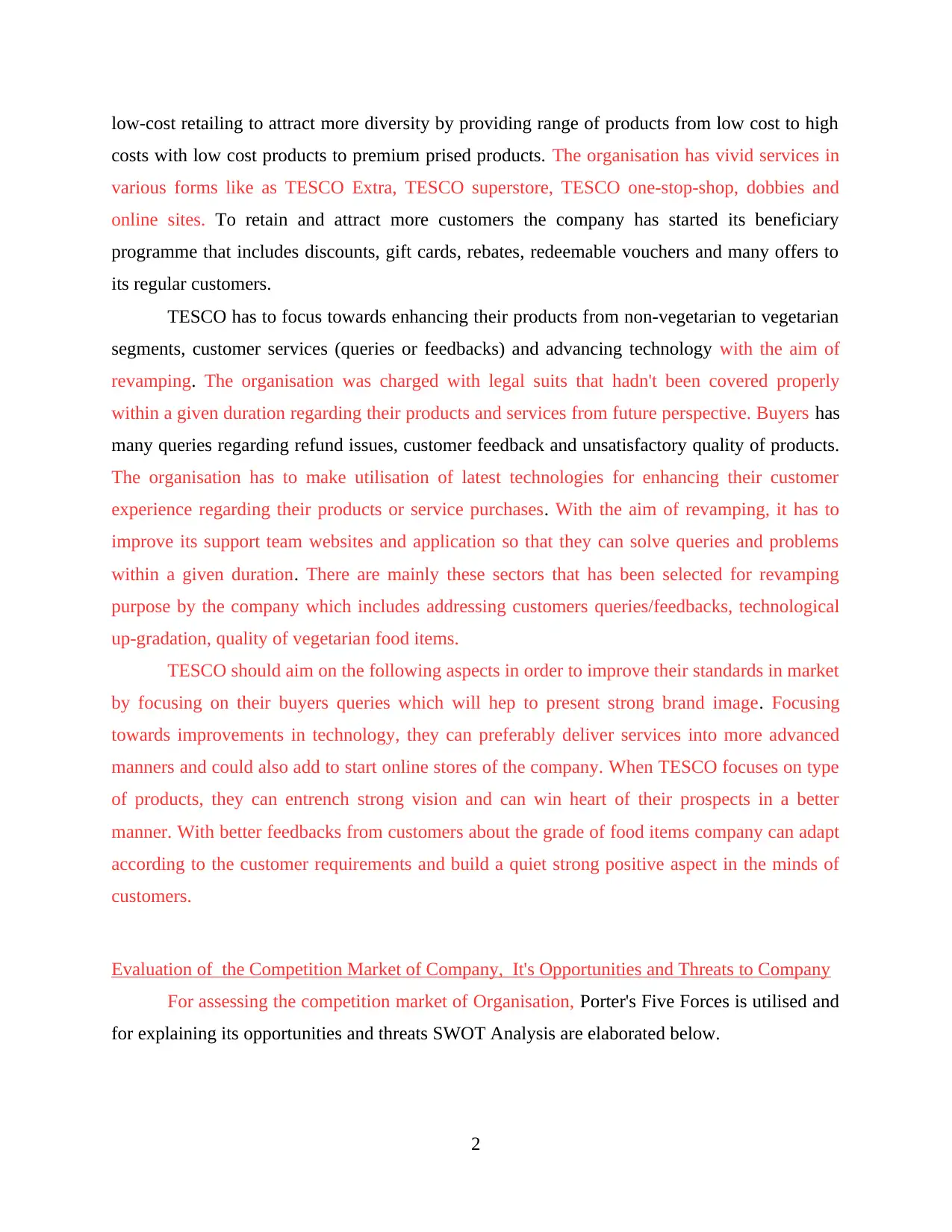
low-cost retailing to attract more diversity by providing range of products from low cost to high
costs with low cost products to premium prised products. The organisation has vivid services in
various forms like as TESCO Extra, TESCO superstore, TESCO one-stop-shop, dobbies and
online sites. To retain and attract more customers the company has started its beneficiary
programme that includes discounts, gift cards, rebates, redeemable vouchers and many offers to
its regular customers.
TESCO has to focus towards enhancing their products from non-vegetarian to vegetarian
segments, customer services (queries or feedbacks) and advancing technology with the aim of
revamping. The organisation was charged with legal suits that hadn't been covered properly
within a given duration regarding their products and services from future perspective. Buyers has
many queries regarding refund issues, customer feedback and unsatisfactory quality of products.
The organisation has to make utilisation of latest technologies for enhancing their customer
experience regarding their products or service purchases. With the aim of revamping, it has to
improve its support team websites and application so that they can solve queries and problems
within a given duration. There are mainly these sectors that has been selected for revamping
purpose by the company which includes addressing customers queries/feedbacks, technological
up-gradation, quality of vegetarian food items.
TESCO should aim on the following aspects in order to improve their standards in market
by focusing on their buyers queries which will hep to present strong brand image. Focusing
towards improvements in technology, they can preferably deliver services into more advanced
manners and could also add to start online stores of the company. When TESCO focuses on type
of products, they can entrench strong vision and can win heart of their prospects in a better
manner. With better feedbacks from customers about the grade of food items company can adapt
according to the customer requirements and build a quiet strong positive aspect in the minds of
customers.
Evaluation of the Competition Market of Company, It's Opportunities and Threats to Company
For assessing the competition market of Organisation, Porter's Five Forces is utilised and
for explaining its opportunities and threats SWOT Analysis are elaborated below.
2
costs with low cost products to premium prised products. The organisation has vivid services in
various forms like as TESCO Extra, TESCO superstore, TESCO one-stop-shop, dobbies and
online sites. To retain and attract more customers the company has started its beneficiary
programme that includes discounts, gift cards, rebates, redeemable vouchers and many offers to
its regular customers.
TESCO has to focus towards enhancing their products from non-vegetarian to vegetarian
segments, customer services (queries or feedbacks) and advancing technology with the aim of
revamping. The organisation was charged with legal suits that hadn't been covered properly
within a given duration regarding their products and services from future perspective. Buyers has
many queries regarding refund issues, customer feedback and unsatisfactory quality of products.
The organisation has to make utilisation of latest technologies for enhancing their customer
experience regarding their products or service purchases. With the aim of revamping, it has to
improve its support team websites and application so that they can solve queries and problems
within a given duration. There are mainly these sectors that has been selected for revamping
purpose by the company which includes addressing customers queries/feedbacks, technological
up-gradation, quality of vegetarian food items.
TESCO should aim on the following aspects in order to improve their standards in market
by focusing on their buyers queries which will hep to present strong brand image. Focusing
towards improvements in technology, they can preferably deliver services into more advanced
manners and could also add to start online stores of the company. When TESCO focuses on type
of products, they can entrench strong vision and can win heart of their prospects in a better
manner. With better feedbacks from customers about the grade of food items company can adapt
according to the customer requirements and build a quiet strong positive aspect in the minds of
customers.
Evaluation of the Competition Market of Company, It's Opportunities and Threats to Company
For assessing the competition market of Organisation, Porter's Five Forces is utilised and
for explaining its opportunities and threats SWOT Analysis are elaborated below.
2
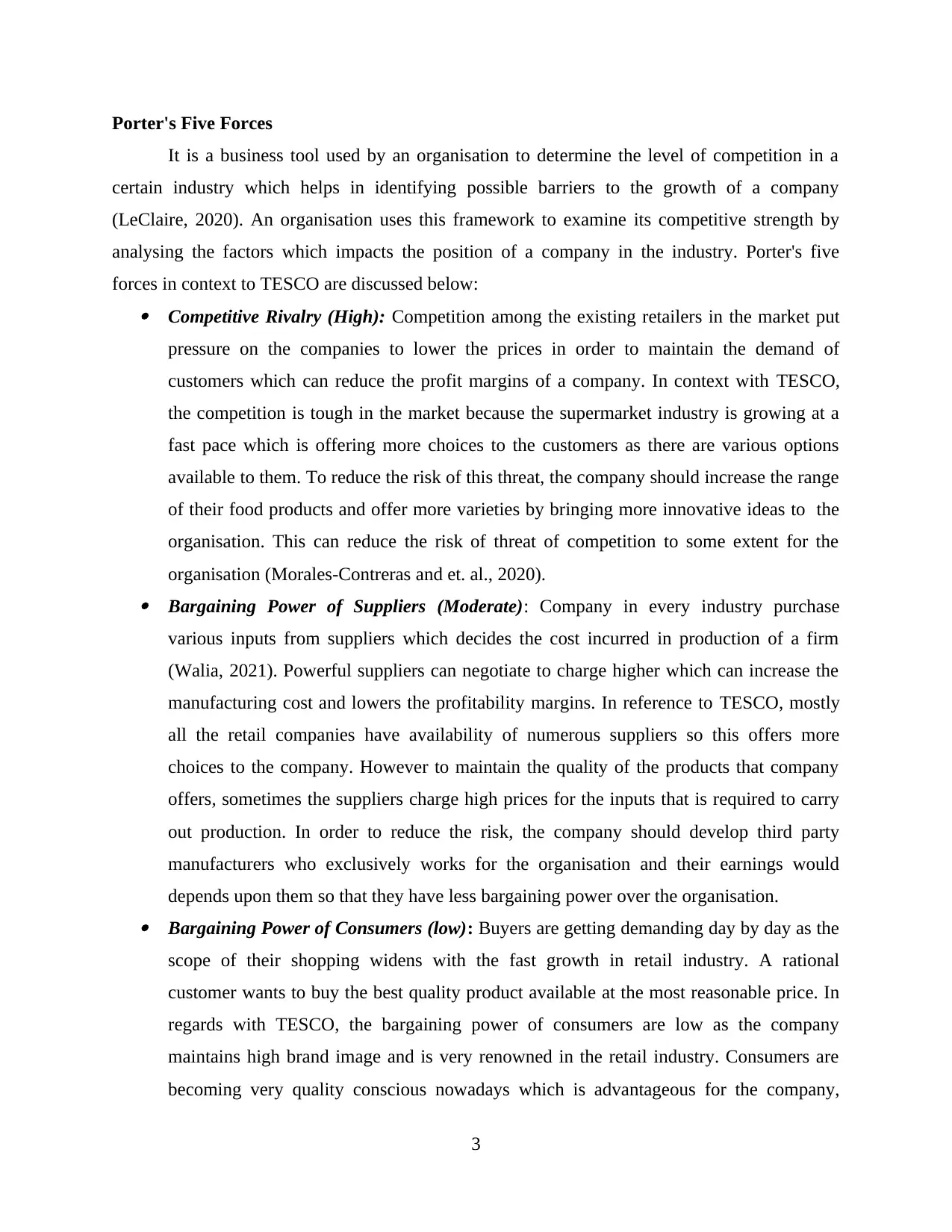
Porter's Five Forces
It is a business tool used by an organisation to determine the level of competition in a
certain industry which helps in identifying possible barriers to the growth of a company
(LeClaire, 2020). An organisation uses this framework to examine its competitive strength by
analysing the factors which impacts the position of a company in the industry. Porter's five
forces in context to TESCO are discussed below: Competitive Rivalry (High): Competition among the existing retailers in the market put
pressure on the companies to lower the prices in order to maintain the demand of
customers which can reduce the profit margins of a company. In context with TESCO,
the competition is tough in the market because the supermarket industry is growing at a
fast pace which is offering more choices to the customers as there are various options
available to them. To reduce the risk of this threat, the company should increase the range
of their food products and offer more varieties by bringing more innovative ideas to the
organisation. This can reduce the risk of threat of competition to some extent for the
organisation (Morales-Contreras and et. al., 2020). Bargaining Power of Suppliers (Moderate): Company in every industry purchase
various inputs from suppliers which decides the cost incurred in production of a firm
(Walia, 2021). Powerful suppliers can negotiate to charge higher which can increase the
manufacturing cost and lowers the profitability margins. In reference to TESCO, mostly
all the retail companies have availability of numerous suppliers so this offers more
choices to the company. However to maintain the quality of the products that company
offers, sometimes the suppliers charge high prices for the inputs that is required to carry
out production. In order to reduce the risk, the company should develop third party
manufacturers who exclusively works for the organisation and their earnings would
depends upon them so that they have less bargaining power over the organisation. Bargaining Power of Consumers (low): Buyers are getting demanding day by day as the
scope of their shopping widens with the fast growth in retail industry. A rational
customer wants to buy the best quality product available at the most reasonable price. In
regards with TESCO, the bargaining power of consumers are low as the company
maintains high brand image and is very renowned in the retail industry. Consumers are
becoming very quality conscious nowadays which is advantageous for the company,
3
It is a business tool used by an organisation to determine the level of competition in a
certain industry which helps in identifying possible barriers to the growth of a company
(LeClaire, 2020). An organisation uses this framework to examine its competitive strength by
analysing the factors which impacts the position of a company in the industry. Porter's five
forces in context to TESCO are discussed below: Competitive Rivalry (High): Competition among the existing retailers in the market put
pressure on the companies to lower the prices in order to maintain the demand of
customers which can reduce the profit margins of a company. In context with TESCO,
the competition is tough in the market because the supermarket industry is growing at a
fast pace which is offering more choices to the customers as there are various options
available to them. To reduce the risk of this threat, the company should increase the range
of their food products and offer more varieties by bringing more innovative ideas to the
organisation. This can reduce the risk of threat of competition to some extent for the
organisation (Morales-Contreras and et. al., 2020). Bargaining Power of Suppliers (Moderate): Company in every industry purchase
various inputs from suppliers which decides the cost incurred in production of a firm
(Walia, 2021). Powerful suppliers can negotiate to charge higher which can increase the
manufacturing cost and lowers the profitability margins. In reference to TESCO, mostly
all the retail companies have availability of numerous suppliers so this offers more
choices to the company. However to maintain the quality of the products that company
offers, sometimes the suppliers charge high prices for the inputs that is required to carry
out production. In order to reduce the risk, the company should develop third party
manufacturers who exclusively works for the organisation and their earnings would
depends upon them so that they have less bargaining power over the organisation. Bargaining Power of Consumers (low): Buyers are getting demanding day by day as the
scope of their shopping widens with the fast growth in retail industry. A rational
customer wants to buy the best quality product available at the most reasonable price. In
regards with TESCO, the bargaining power of consumers are low as the company
maintains high brand image and is very renowned in the retail industry. Consumers are
becoming very quality conscious nowadays which is advantageous for the company,
3
⊘ This is a preview!⊘
Do you want full access?
Subscribe today to unlock all pages.

Trusted by 1+ million students worldwide
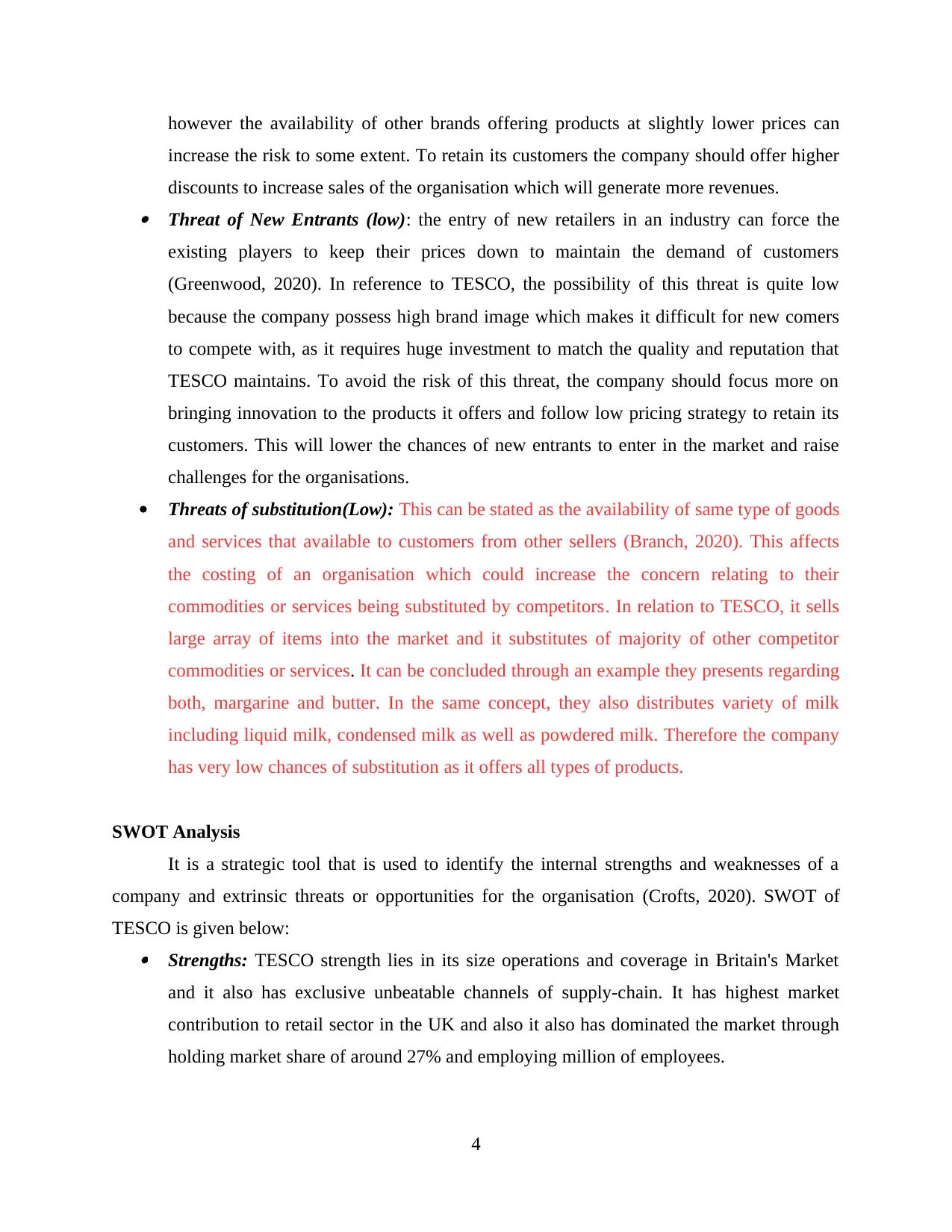
however the availability of other brands offering products at slightly lower prices can
increase the risk to some extent. To retain its customers the company should offer higher
discounts to increase sales of the organisation which will generate more revenues. Threat of New Entrants (low): the entry of new retailers in an industry can force the
existing players to keep their prices down to maintain the demand of customers
(Greenwood, 2020). In reference to TESCO, the possibility of this threat is quite low
because the company possess high brand image which makes it difficult for new comers
to compete with, as it requires huge investment to match the quality and reputation that
TESCO maintains. To avoid the risk of this threat, the company should focus more on
bringing innovation to the products it offers and follow low pricing strategy to retain its
customers. This will lower the chances of new entrants to enter in the market and raise
challenges for the organisations.
Threats of substitution(Low): This can be stated as the availability of same type of goods
and services that available to customers from other sellers (Branch, 2020). This affects
the costing of an organisation which could increase the concern relating to their
commodities or services being substituted by competitors. In relation to TESCO, it sells
large array of items into the market and it substitutes of majority of other competitor
commodities or services. It can be concluded through an example they presents regarding
both, margarine and butter. In the same concept, they also distributes variety of milk
including liquid milk, condensed milk as well as powdered milk. Therefore the company
has very low chances of substitution as it offers all types of products.
SWOT Analysis
It is a strategic tool that is used to identify the internal strengths and weaknesses of a
company and extrinsic threats or opportunities for the organisation (Crofts, 2020). SWOT of
TESCO is given below: Strengths: TESCO strength lies in its size operations and coverage in Britain's Market
and it also has exclusive unbeatable channels of supply-chain. It has highest market
contribution to retail sector in the UK and also it also has dominated the market through
holding market share of around 27% and employing million of employees.
4
increase the risk to some extent. To retain its customers the company should offer higher
discounts to increase sales of the organisation which will generate more revenues. Threat of New Entrants (low): the entry of new retailers in an industry can force the
existing players to keep their prices down to maintain the demand of customers
(Greenwood, 2020). In reference to TESCO, the possibility of this threat is quite low
because the company possess high brand image which makes it difficult for new comers
to compete with, as it requires huge investment to match the quality and reputation that
TESCO maintains. To avoid the risk of this threat, the company should focus more on
bringing innovation to the products it offers and follow low pricing strategy to retain its
customers. This will lower the chances of new entrants to enter in the market and raise
challenges for the organisations.
Threats of substitution(Low): This can be stated as the availability of same type of goods
and services that available to customers from other sellers (Branch, 2020). This affects
the costing of an organisation which could increase the concern relating to their
commodities or services being substituted by competitors. In relation to TESCO, it sells
large array of items into the market and it substitutes of majority of other competitor
commodities or services. It can be concluded through an example they presents regarding
both, margarine and butter. In the same concept, they also distributes variety of milk
including liquid milk, condensed milk as well as powdered milk. Therefore the company
has very low chances of substitution as it offers all types of products.
SWOT Analysis
It is a strategic tool that is used to identify the internal strengths and weaknesses of a
company and extrinsic threats or opportunities for the organisation (Crofts, 2020). SWOT of
TESCO is given below: Strengths: TESCO strength lies in its size operations and coverage in Britain's Market
and it also has exclusive unbeatable channels of supply-chain. It has highest market
contribution to retail sector in the UK and also it also has dominated the market through
holding market share of around 27% and employing million of employees.
4
Paraphrase This Document
Need a fresh take? Get an instant paraphrase of this document with our AI Paraphraser
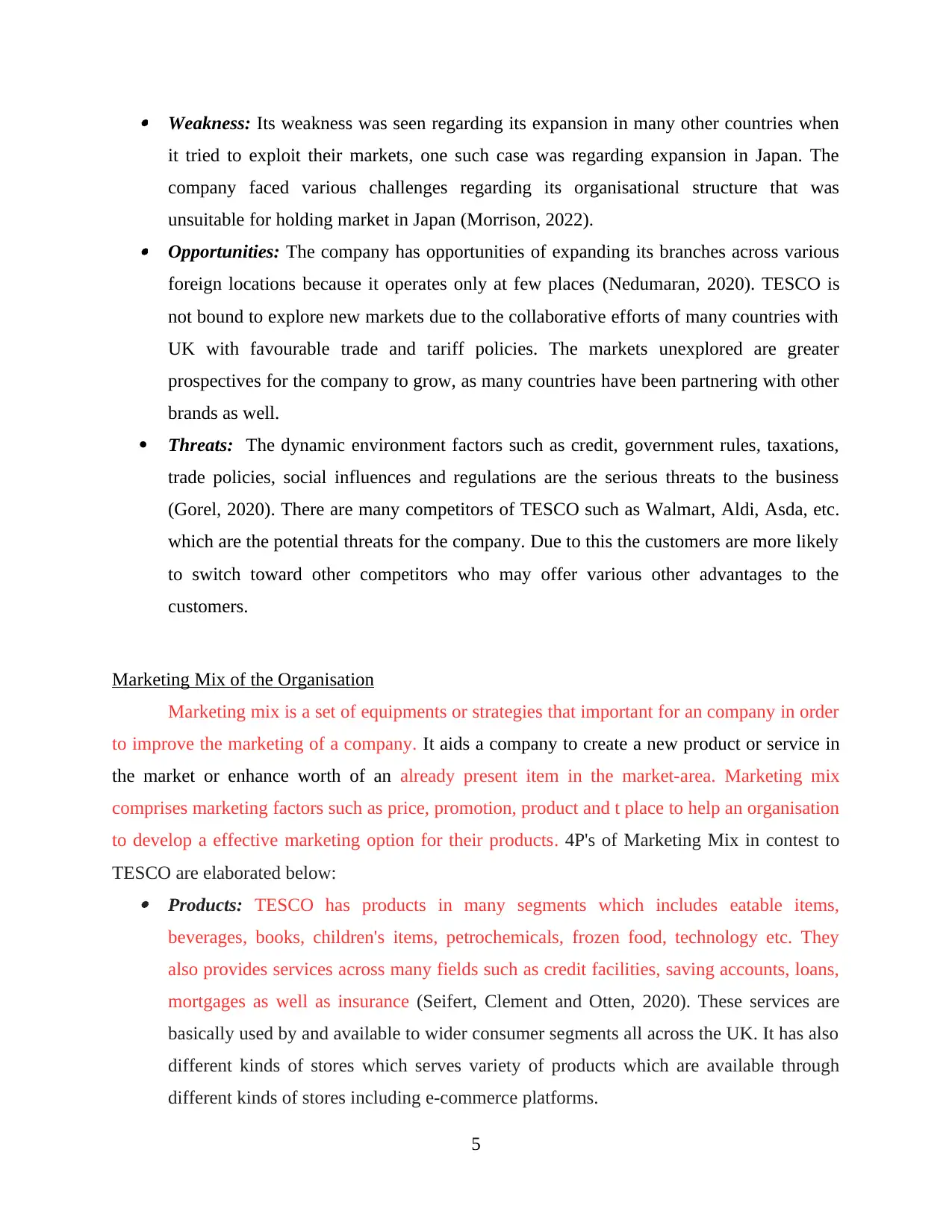
Weakness: Its weakness was seen regarding its expansion in many other countries when
it tried to exploit their markets, one such case was regarding expansion in Japan. The
company faced various challenges regarding its organisational structure that was
unsuitable for holding market in Japan (Morrison, 2022). Opportunities: The company has opportunities of expanding its branches across various
foreign locations because it operates only at few places (Nedumaran, 2020). TESCO is
not bound to explore new markets due to the collaborative efforts of many countries with
UK with favourable trade and tariff policies. The markets unexplored are greater
prospectives for the company to grow, as many countries have been partnering with other
brands as well.
Threats: The dynamic environment factors such as credit, government rules, taxations,
trade policies, social influences and regulations are the serious threats to the business
(Gorel, 2020). There are many competitors of TESCO such as Walmart, Aldi, Asda, etc.
which are the potential threats for the company. Due to this the customers are more likely
to switch toward other competitors who may offer various other advantages to the
customers.
Marketing Mix of the Organisation
Marketing mix is a set of equipments or strategies that important for an company in order
to improve the marketing of a company. It aids a company to create a new product or service in
the market or enhance worth of an already present item in the market-area. Marketing mix
comprises marketing factors such as price, promotion, product and t place to help an organisation
to develop a effective marketing option for their products. 4P's of Marketing Mix in contest to
TESCO are elaborated below: Products: TESCO has products in many segments which includes eatable items,
beverages, books, children's items, petrochemicals, frozen food, technology etc. They
also provides services across many fields such as credit facilities, saving accounts, loans,
mortgages as well as insurance (Seifert, Clement and Otten, 2020). These services are
basically used by and available to wider consumer segments all across the UK. It has also
different kinds of stores which serves variety of products which are available through
different kinds of stores including e-commerce platforms.
5
it tried to exploit their markets, one such case was regarding expansion in Japan. The
company faced various challenges regarding its organisational structure that was
unsuitable for holding market in Japan (Morrison, 2022). Opportunities: The company has opportunities of expanding its branches across various
foreign locations because it operates only at few places (Nedumaran, 2020). TESCO is
not bound to explore new markets due to the collaborative efforts of many countries with
UK with favourable trade and tariff policies. The markets unexplored are greater
prospectives for the company to grow, as many countries have been partnering with other
brands as well.
Threats: The dynamic environment factors such as credit, government rules, taxations,
trade policies, social influences and regulations are the serious threats to the business
(Gorel, 2020). There are many competitors of TESCO such as Walmart, Aldi, Asda, etc.
which are the potential threats for the company. Due to this the customers are more likely
to switch toward other competitors who may offer various other advantages to the
customers.
Marketing Mix of the Organisation
Marketing mix is a set of equipments or strategies that important for an company in order
to improve the marketing of a company. It aids a company to create a new product or service in
the market or enhance worth of an already present item in the market-area. Marketing mix
comprises marketing factors such as price, promotion, product and t place to help an organisation
to develop a effective marketing option for their products. 4P's of Marketing Mix in contest to
TESCO are elaborated below: Products: TESCO has products in many segments which includes eatable items,
beverages, books, children's items, petrochemicals, frozen food, technology etc. They
also provides services across many fields such as credit facilities, saving accounts, loans,
mortgages as well as insurance (Seifert, Clement and Otten, 2020). These services are
basically used by and available to wider consumer segments all across the UK. It has also
different kinds of stores which serves variety of products which are available through
different kinds of stores including e-commerce platforms.
5
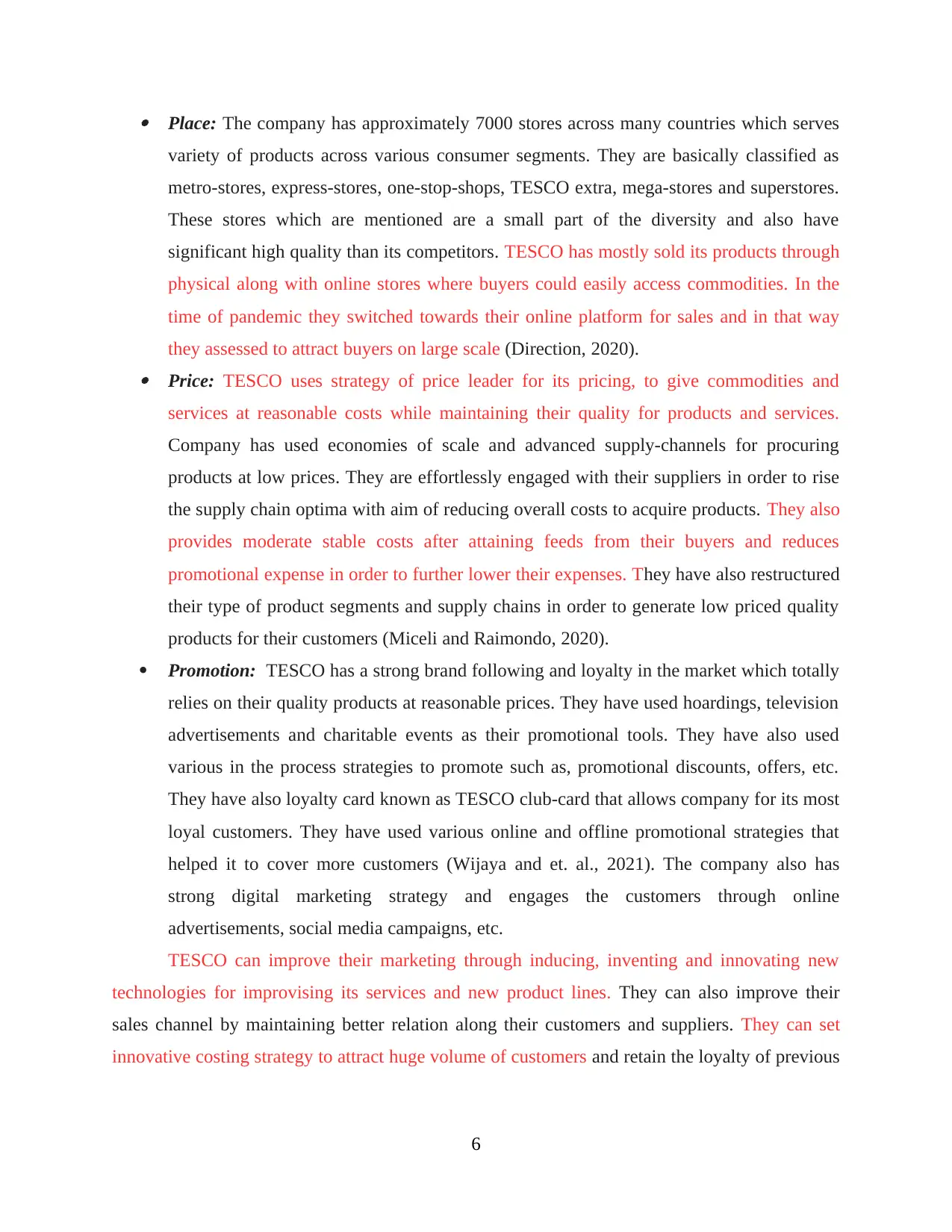
Place: The company has approximately 7000 stores across many countries which serves
variety of products across various consumer segments. They are basically classified as
metro-stores, express-stores, one-stop-shops, TESCO extra, mega-stores and superstores.
These stores which are mentioned are a small part of the diversity and also have
significant high quality than its competitors. TESCO has mostly sold its products through
physical along with online stores where buyers could easily access commodities. In the
time of pandemic they switched towards their online platform for sales and in that way
they assessed to attract buyers on large scale (Direction, 2020). Price: TESCO uses strategy of price leader for its pricing, to give commodities and
services at reasonable costs while maintaining their quality for products and services.
Company has used economies of scale and advanced supply-channels for procuring
products at low prices. They are effortlessly engaged with their suppliers in order to rise
the supply chain optima with aim of reducing overall costs to acquire products. They also
provides moderate stable costs after attaining feeds from their buyers and reduces
promotional expense in order to further lower their expenses. They have also restructured
their type of product segments and supply chains in order to generate low priced quality
products for their customers (Miceli and Raimondo, 2020).
Promotion: TESCO has a strong brand following and loyalty in the market which totally
relies on their quality products at reasonable prices. They have used hoardings, television
advertisements and charitable events as their promotional tools. They have also used
various in the process strategies to promote such as, promotional discounts, offers, etc.
They have also loyalty card known as TESCO club-card that allows company for its most
loyal customers. They have used various online and offline promotional strategies that
helped it to cover more customers (Wijaya and et. al., 2021). The company also has
strong digital marketing strategy and engages the customers through online
advertisements, social media campaigns, etc.
TESCO can improve their marketing through inducing, inventing and innovating new
technologies for improvising its services and new product lines. They can also improve their
sales channel by maintaining better relation along their customers and suppliers. They can set
innovative costing strategy to attract huge volume of customers and retain the loyalty of previous
6
variety of products across various consumer segments. They are basically classified as
metro-stores, express-stores, one-stop-shops, TESCO extra, mega-stores and superstores.
These stores which are mentioned are a small part of the diversity and also have
significant high quality than its competitors. TESCO has mostly sold its products through
physical along with online stores where buyers could easily access commodities. In the
time of pandemic they switched towards their online platform for sales and in that way
they assessed to attract buyers on large scale (Direction, 2020). Price: TESCO uses strategy of price leader for its pricing, to give commodities and
services at reasonable costs while maintaining their quality for products and services.
Company has used economies of scale and advanced supply-channels for procuring
products at low prices. They are effortlessly engaged with their suppliers in order to rise
the supply chain optima with aim of reducing overall costs to acquire products. They also
provides moderate stable costs after attaining feeds from their buyers and reduces
promotional expense in order to further lower their expenses. They have also restructured
their type of product segments and supply chains in order to generate low priced quality
products for their customers (Miceli and Raimondo, 2020).
Promotion: TESCO has a strong brand following and loyalty in the market which totally
relies on their quality products at reasonable prices. They have used hoardings, television
advertisements and charitable events as their promotional tools. They have also used
various in the process strategies to promote such as, promotional discounts, offers, etc.
They have also loyalty card known as TESCO club-card that allows company for its most
loyal customers. They have used various online and offline promotional strategies that
helped it to cover more customers (Wijaya and et. al., 2021). The company also has
strong digital marketing strategy and engages the customers through online
advertisements, social media campaigns, etc.
TESCO can improve their marketing through inducing, inventing and innovating new
technologies for improvising its services and new product lines. They can also improve their
sales channel by maintaining better relation along their customers and suppliers. They can set
innovative costing strategy to attract huge volume of customers and retain the loyalty of previous
6
⊘ This is a preview!⊘
Do you want full access?
Subscribe today to unlock all pages.

Trusted by 1+ million students worldwide
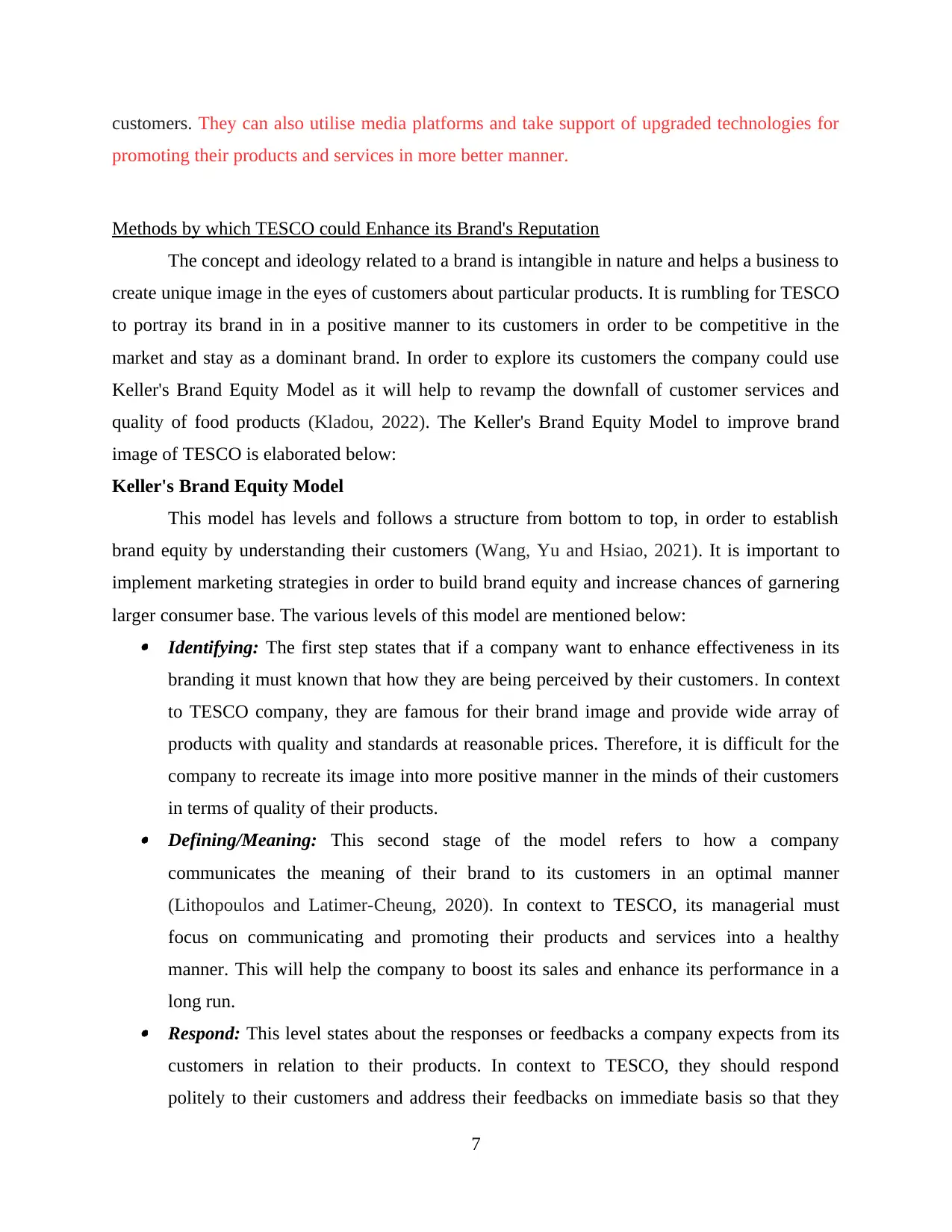
customers. They can also utilise media platforms and take support of upgraded technologies for
promoting their products and services in more better manner.
Methods by which TESCO could Enhance its Brand's Reputation
The concept and ideology related to a brand is intangible in nature and helps a business to
create unique image in the eyes of customers about particular products. It is rumbling for TESCO
to portray its brand in in a positive manner to its customers in order to be competitive in the
market and stay as a dominant brand. In order to explore its customers the company could use
Keller's Brand Equity Model as it will help to revamp the downfall of customer services and
quality of food products (Kladou, 2022). The Keller's Brand Equity Model to improve brand
image of TESCO is elaborated below:
Keller's Brand Equity Model
This model has levels and follows a structure from bottom to top, in order to establish
brand equity by understanding their customers (Wang, Yu and Hsiao, 2021). It is important to
implement marketing strategies in order to build brand equity and increase chances of garnering
larger consumer base. The various levels of this model are mentioned below: Identifying: The first step states that if a company want to enhance effectiveness in its
branding it must known that how they are being perceived by their customers. In context
to TESCO company, they are famous for their brand image and provide wide array of
products with quality and standards at reasonable prices. Therefore, it is difficult for the
company to recreate its image into more positive manner in the minds of their customers
in terms of quality of their products. Defining/Meaning: This second stage of the model refers to how a company
communicates the meaning of their brand to its customers in an optimal manner
(Lithopoulos and Latimer-Cheung, 2020). In context to TESCO, its managerial must
focus on communicating and promoting their products and services into a healthy
manner. This will help the company to boost its sales and enhance its performance in a
long run. Respond: This level states about the responses or feedbacks a company expects from its
customers in relation to their products. In context to TESCO, they should respond
politely to their customers and address their feedbacks on immediate basis so that they
7
promoting their products and services in more better manner.
Methods by which TESCO could Enhance its Brand's Reputation
The concept and ideology related to a brand is intangible in nature and helps a business to
create unique image in the eyes of customers about particular products. It is rumbling for TESCO
to portray its brand in in a positive manner to its customers in order to be competitive in the
market and stay as a dominant brand. In order to explore its customers the company could use
Keller's Brand Equity Model as it will help to revamp the downfall of customer services and
quality of food products (Kladou, 2022). The Keller's Brand Equity Model to improve brand
image of TESCO is elaborated below:
Keller's Brand Equity Model
This model has levels and follows a structure from bottom to top, in order to establish
brand equity by understanding their customers (Wang, Yu and Hsiao, 2021). It is important to
implement marketing strategies in order to build brand equity and increase chances of garnering
larger consumer base. The various levels of this model are mentioned below: Identifying: The first step states that if a company want to enhance effectiveness in its
branding it must known that how they are being perceived by their customers. In context
to TESCO company, they are famous for their brand image and provide wide array of
products with quality and standards at reasonable prices. Therefore, it is difficult for the
company to recreate its image into more positive manner in the minds of their customers
in terms of quality of their products. Defining/Meaning: This second stage of the model refers to how a company
communicates the meaning of their brand to its customers in an optimal manner
(Lithopoulos and Latimer-Cheung, 2020). In context to TESCO, its managerial must
focus on communicating and promoting their products and services into a healthy
manner. This will help the company to boost its sales and enhance its performance in a
long run. Respond: This level states about the responses or feedbacks a company expects from its
customers in relation to their products. In context to TESCO, they should respond
politely to their customers and address their feedbacks on immediate basis so that they
7
Paraphrase This Document
Need a fresh take? Get an instant paraphrase of this document with our AI Paraphraser
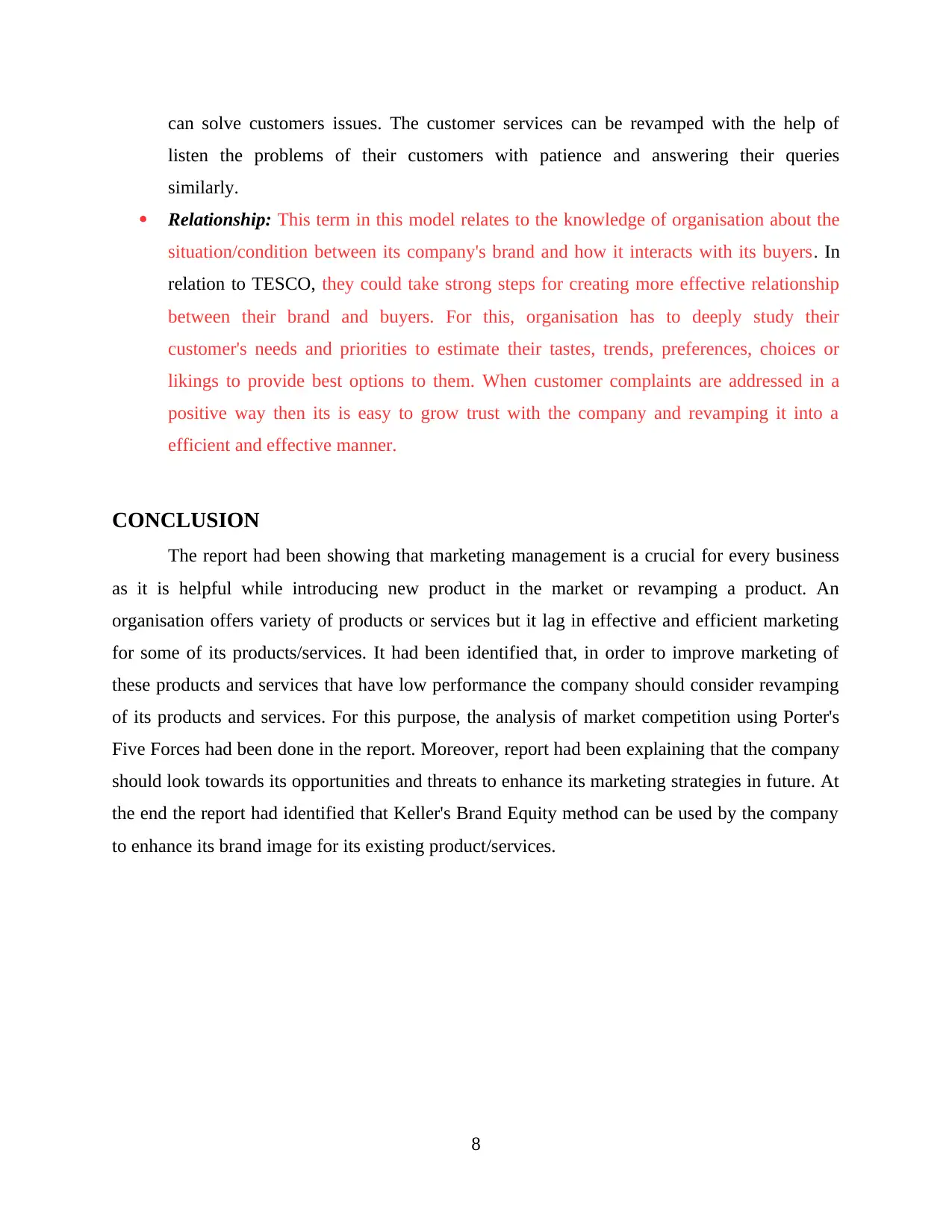
can solve customers issues. The customer services can be revamped with the help of
listen the problems of their customers with patience and answering their queries
similarly.
Relationship: This term in this model relates to the knowledge of organisation about the
situation/condition between its company's brand and how it interacts with its buyers. In
relation to TESCO, they could take strong steps for creating more effective relationship
between their brand and buyers. For this, organisation has to deeply study their
customer's needs and priorities to estimate their tastes, trends, preferences, choices or
likings to provide best options to them. When customer complaints are addressed in a
positive way then its is easy to grow trust with the company and revamping it into a
efficient and effective manner.
CONCLUSION
The report had been showing that marketing management is a crucial for every business
as it is helpful while introducing new product in the market or revamping a product. An
organisation offers variety of products or services but it lag in effective and efficient marketing
for some of its products/services. It had been identified that, in order to improve marketing of
these products and services that have low performance the company should consider revamping
of its products and services. For this purpose, the analysis of market competition using Porter's
Five Forces had been done in the report. Moreover, report had been explaining that the company
should look towards its opportunities and threats to enhance its marketing strategies in future. At
the end the report had identified that Keller's Brand Equity method can be used by the company
to enhance its brand image for its existing product/services.
8
listen the problems of their customers with patience and answering their queries
similarly.
Relationship: This term in this model relates to the knowledge of organisation about the
situation/condition between its company's brand and how it interacts with its buyers. In
relation to TESCO, they could take strong steps for creating more effective relationship
between their brand and buyers. For this, organisation has to deeply study their
customer's needs and priorities to estimate their tastes, trends, preferences, choices or
likings to provide best options to them. When customer complaints are addressed in a
positive way then its is easy to grow trust with the company and revamping it into a
efficient and effective manner.
CONCLUSION
The report had been showing that marketing management is a crucial for every business
as it is helpful while introducing new product in the market or revamping a product. An
organisation offers variety of products or services but it lag in effective and efficient marketing
for some of its products/services. It had been identified that, in order to improve marketing of
these products and services that have low performance the company should consider revamping
of its products and services. For this purpose, the analysis of market competition using Porter's
Five Forces had been done in the report. Moreover, report had been explaining that the company
should look towards its opportunities and threats to enhance its marketing strategies in future. At
the end the report had identified that Keller's Brand Equity method can be used by the company
to enhance its brand image for its existing product/services.
8
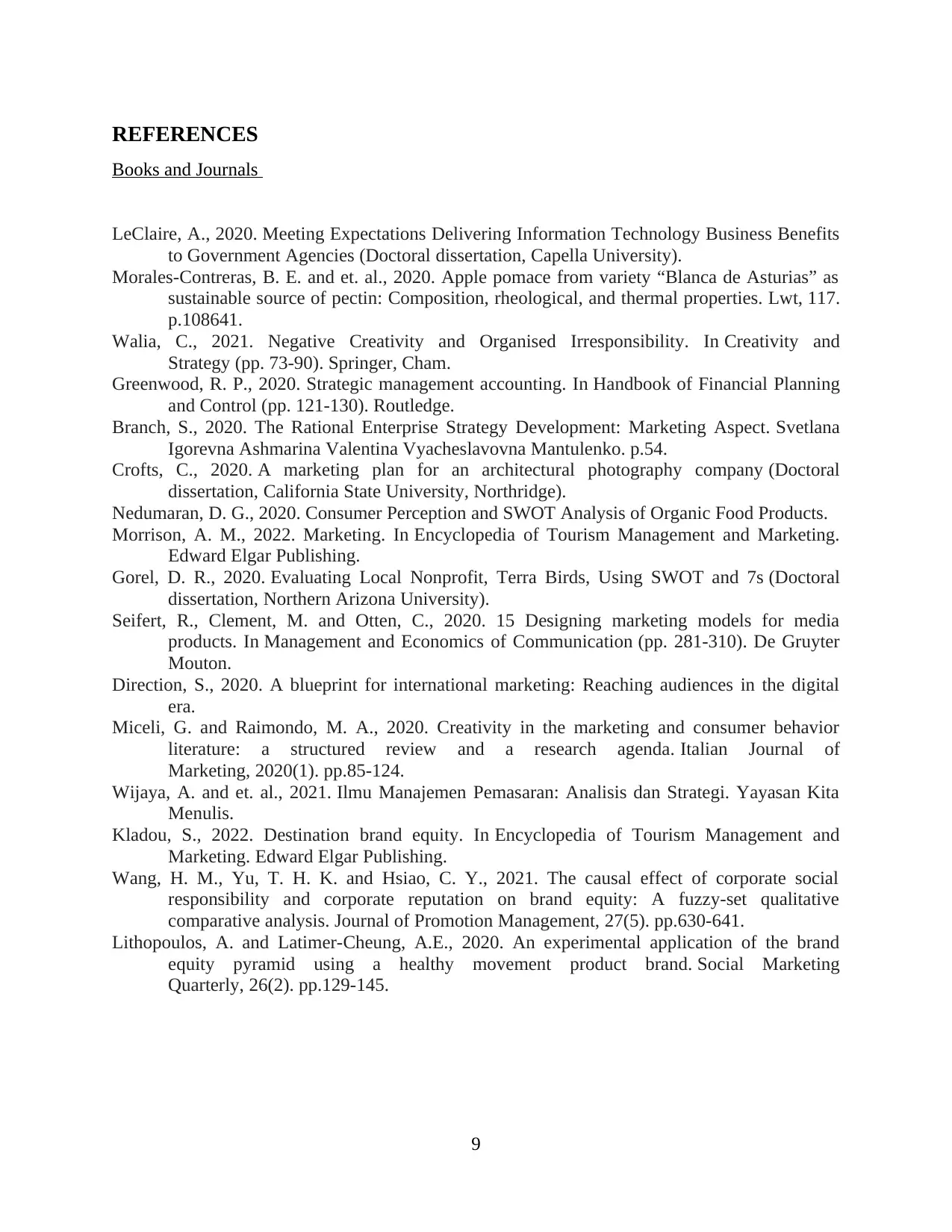
REFERENCES
Books and Journals
LeClaire, A., 2020. Meeting Expectations Delivering Information Technology Business Benefits
to Government Agencies (Doctoral dissertation, Capella University).
Morales-Contreras, B. E. and et. al., 2020. Apple pomace from variety “Blanca de Asturias” as
sustainable source of pectin: Composition, rheological, and thermal properties. Lwt, 117.
p.108641.
Walia, C., 2021. Negative Creativity and Organised Irresponsibility. In Creativity and
Strategy (pp. 73-90). Springer, Cham.
Greenwood, R. P., 2020. Strategic management accounting. In Handbook of Financial Planning
and Control (pp. 121-130). Routledge.
Branch, S., 2020. The Rational Enterprise Strategy Development: Marketing Aspect. Svetlana
Igorevna Ashmarina Valentina Vyacheslavovna Mantulenko. p.54.
Crofts, C., 2020. A marketing plan for an architectural photography company (Doctoral
dissertation, California State University, Northridge).
Nedumaran, D. G., 2020. Consumer Perception and SWOT Analysis of Organic Food Products.
Morrison, A. M., 2022. Marketing. In Encyclopedia of Tourism Management and Marketing.
Edward Elgar Publishing.
Gorel, D. R., 2020. Evaluating Local Nonprofit, Terra Birds, Using SWOT and 7s (Doctoral
dissertation, Northern Arizona University).
Seifert, R., Clement, M. and Otten, C., 2020. 15 Designing marketing models for media
products. In Management and Economics of Communication (pp. 281-310). De Gruyter
Mouton.
Direction, S., 2020. A blueprint for international marketing: Reaching audiences in the digital
era.
Miceli, G. and Raimondo, M. A., 2020. Creativity in the marketing and consumer behavior
literature: a structured review and a research agenda. Italian Journal of
Marketing, 2020(1). pp.85-124.
Wijaya, A. and et. al., 2021. Ilmu Manajemen Pemasaran: Analisis dan Strategi. Yayasan Kita
Menulis.
Kladou, S., 2022. Destination brand equity. In Encyclopedia of Tourism Management and
Marketing. Edward Elgar Publishing.
Wang, H. M., Yu, T. H. K. and Hsiao, C. Y., 2021. The causal effect of corporate social
responsibility and corporate reputation on brand equity: A fuzzy-set qualitative
comparative analysis. Journal of Promotion Management, 27(5). pp.630-641.
Lithopoulos, A. and Latimer-Cheung, A.E., 2020. An experimental application of the brand
equity pyramid using a healthy movement product brand. Social Marketing
Quarterly, 26(2). pp.129-145.
9
Books and Journals
LeClaire, A., 2020. Meeting Expectations Delivering Information Technology Business Benefits
to Government Agencies (Doctoral dissertation, Capella University).
Morales-Contreras, B. E. and et. al., 2020. Apple pomace from variety “Blanca de Asturias” as
sustainable source of pectin: Composition, rheological, and thermal properties. Lwt, 117.
p.108641.
Walia, C., 2021. Negative Creativity and Organised Irresponsibility. In Creativity and
Strategy (pp. 73-90). Springer, Cham.
Greenwood, R. P., 2020. Strategic management accounting. In Handbook of Financial Planning
and Control (pp. 121-130). Routledge.
Branch, S., 2020. The Rational Enterprise Strategy Development: Marketing Aspect. Svetlana
Igorevna Ashmarina Valentina Vyacheslavovna Mantulenko. p.54.
Crofts, C., 2020. A marketing plan for an architectural photography company (Doctoral
dissertation, California State University, Northridge).
Nedumaran, D. G., 2020. Consumer Perception and SWOT Analysis of Organic Food Products.
Morrison, A. M., 2022. Marketing. In Encyclopedia of Tourism Management and Marketing.
Edward Elgar Publishing.
Gorel, D. R., 2020. Evaluating Local Nonprofit, Terra Birds, Using SWOT and 7s (Doctoral
dissertation, Northern Arizona University).
Seifert, R., Clement, M. and Otten, C., 2020. 15 Designing marketing models for media
products. In Management and Economics of Communication (pp. 281-310). De Gruyter
Mouton.
Direction, S., 2020. A blueprint for international marketing: Reaching audiences in the digital
era.
Miceli, G. and Raimondo, M. A., 2020. Creativity in the marketing and consumer behavior
literature: a structured review and a research agenda. Italian Journal of
Marketing, 2020(1). pp.85-124.
Wijaya, A. and et. al., 2021. Ilmu Manajemen Pemasaran: Analisis dan Strategi. Yayasan Kita
Menulis.
Kladou, S., 2022. Destination brand equity. In Encyclopedia of Tourism Management and
Marketing. Edward Elgar Publishing.
Wang, H. M., Yu, T. H. K. and Hsiao, C. Y., 2021. The causal effect of corporate social
responsibility and corporate reputation on brand equity: A fuzzy-set qualitative
comparative analysis. Journal of Promotion Management, 27(5). pp.630-641.
Lithopoulos, A. and Latimer-Cheung, A.E., 2020. An experimental application of the brand
equity pyramid using a healthy movement product brand. Social Marketing
Quarterly, 26(2). pp.129-145.
9
⊘ This is a preview!⊘
Do you want full access?
Subscribe today to unlock all pages.

Trusted by 1+ million students worldwide
1 out of 12
Related Documents
Your All-in-One AI-Powered Toolkit for Academic Success.
+13062052269
info@desklib.com
Available 24*7 on WhatsApp / Email
![[object Object]](/_next/static/media/star-bottom.7253800d.svg)
Unlock your academic potential
Copyright © 2020–2025 A2Z Services. All Rights Reserved. Developed and managed by ZUCOL.





